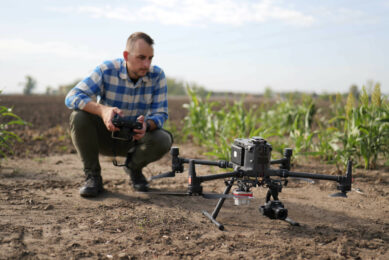Advancements in agricultural drones: Innovations and market trends

There is a growing presence of drones in the agricultural market, boasting impressive flight endurance and payload capacities. Among these innovations, Brazilian company Agrobee is advancing with the development of new VTOL drones capable of carrying up to 900 litres of pesticides.
Recently unveiled at Agrishow 2024, Brazil’s premier agricultural technology event, the VTOL Agrobee 200 garnered significant attention. As a VTOL (Vertical Take-Off and Landing) aircraft, this drone offers the flexibility of vertical liftoff and landing, along with the ability to operate at low speeds, making it highly adaptable for agricultural tasks
The VTOL Agrobee 200 boasts a flight endurance of up to 1 hour and 20 minutes and can carry payloads of up to 200 kg of pesticides. Notably, it achieved sales of 50 units during Agrishow 2024. The VTOL Agrobee 200’s exceptional performance is made possible by its innovative small flex engine, which can run on ethanol, diesel, or gasoline. This engine powers a battery, extending flight times significantly.
The Agrobee 200’s efficiency allows it to cover up to 380 hectares per day, capable of nearly continuous operation with brief, five-minute refuelling intervals. Agrobee’s future plans include the development of two additional drone models with capacities of 100 and 900 liters of pesticides respectively.
Commercial eVTOL services
Guardian Agriculture, a pioneer in autonomous electric VTOL drones for agricultural applications, commenced commercial operations in the US last season. It holds the distinction of being the first company to obtain Federal Aviation Administration (FAA) approval for commercial eVTOL services in the US.
Operating primarily in California’s Salinas Valley, where the terrain’s undulating hills often necessitate helicopter spraying, Guardian’s SC1 drone is optimised for automated spraying and seeding. It follows pre-programmed flight paths synchronised with GPS field maps. Capable of carrying up to 200 pounds (90.7 kg) of liquid payload, the SC1 covers approximately 40 acres (16.19 hectares) per hour, factoring in charging and refilling operations.
Meanwhile, US manufacturer Pyka received FAA approval to conduct commercial operations nationwide with its autonomous crop spraying aircraft, the Pelican. Weighing 1,125 lbs (510 kgs), this electric unmanned aerial system (UAS) is the largest ever authorised by the FAA for commercial use in the US.
Text continues below picture

Drone swarms
Pyka asserts that the Pelican enhances spray precision, reduces chemical costs, and minimises environmental impact. According to Pyka, the Pelican is the world’s largest and most efficient agricultural spray drone. It is operational across farms in Costa Rica, Honduras, and Brazil. It can carry up to 540 lbs (245 kgs) or 70 gallons (265 litres) of liquid and covers up to 240 acres per hour with its advanced capabilities.
Increasing efficiency in drone operations doesn’t solely rely on scaling up drone sizes. US company Hylio has achieved a significant milestone with its recent FAA approval, marking it as the first US company authorized to operate drone swarms.

This approval permits Hylio to oversee up to three drones, each weighing over 55 pounds, with a single pilot and without a visual observer. This heralds a new era of efficiency in agricultural practices. Arthur Erickson, Co-Founder and CEO of Hylio, sees this as a pivotal moment, paving the way for Hylio’s customers and other drone operators to seek similar permissions for swarming drones weighing 55 pounds (25 kg) or more. This development promises to significantly boost crop productivity.
With three of these drones potentially covering close to 100 to 120 acres (41 to 49 hectares) per hour, the efficiency gains are substantial, Erickson explains. The ability to swarm ensures operators achieve competitive levels of productivity per hour. Looking ahead, Erickson anticipates that five to ten drones will constitute the optimal swarm size in the future, likely weighing between 1000 to 2000 pounds (454 to 908 kg) at most.
Case IH drones
The adoption of drones in US agriculture has surged in recent years. The FAA is actively working on establishing standardised operational rules to make drone usage routine, scalable, and economically feasible.
The expanding market opportunities are evident as companies increasingly invest in this sector. Case IH, a prominent American agricultural machinery manufacturer, has recently announced the upcoming launch of its first sprayer drone, enhancing its product portfolio.
In partnership with XAG, a leading player in the spraying drone segment, Case IH will launch a VTOL drone in Brazil, offering models with capacities of 30 litres and 70 litres. Pricing details will accompany the debut of the products.
The initial launch in Brazil is slated for the second half of this year, with plans for further expansion into other high-demand regions such as Latin America and the Pacific. Case IH recommends deploying these drones post-rain to prevent issues like sprayer or tractor jams, crop damage, and soil compaction.
Text continues below picture

High-quality application
Designed primarily for small and medium-sized farmers, the drones can either supplement or replace traditional sprayers in specific scenarios. Case IH emphasises the versatility of its drones in handling both liquid and solid distributions, ensuring high-quality application with uniform droplet distribution and effective penetration into the plant canopy.
The rapid evolution of drone technology in agriculture clearly marks a profound shift towards efficiency, precision, and sustainability. From the pioneering VTOL capabilities of the Agrobee 200 in Brazil to Guardian Agriculture’s automated SC1 navigating California’s challenging terrain, drones are revolutionising farming practices worldwide.
As regulatory frameworks continue to adapt and industry leaders invest in advancing drone capabilities, the trajectory points towards a future where drones are indispensable tools in modern agriculture.
Join 17,000+ subscribers
Subscribe to our newsletter to stay updated about all the need-to-know content in the agricultural sector, two times a week.



